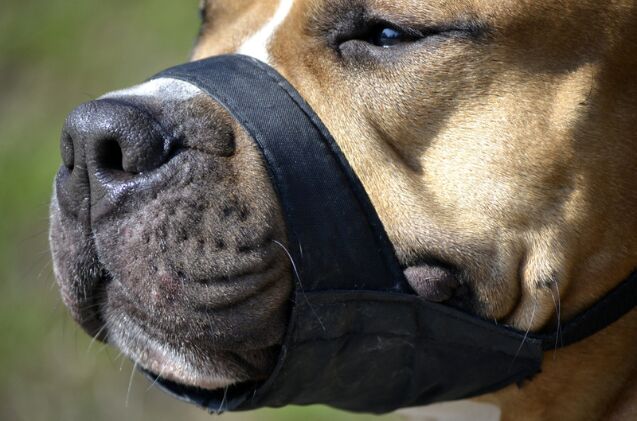Can I Muzzle My Dog to Stop Barking?

Barking is a natural way our dogs communicate with us and other canines in the area, but it can create a problem when they become too vocal. After all, no one wants to be disturbed by excessive barking!
If you’re searching for a solution to quiet your dog and restore peace, you may have seen many people suggest using a muzzle. However, while I am a strong advocate for muzzle training and the use of muzzles for various situations, it’s not always the right tool for the job. Not only are muzzles not the ideal approach to address problem barking, but they may create a dangerous situation.
Let’s dig into the best approach to stop your dog from barking and why a muzzle isn’t the quick fix you may have been sold.
Why Is My Dog Barking So Much?
The first thing to consider anytime you are addressing a problem behavior with your dog is why that problem behavior is occurring, to begin with. Trying to stop the barking itself often doesn’t offer a long-term solution. Instead, you need to focus on addressing the root of the problem.
Some dogs are naturally vocal, making it challenging to identify a cause as it appears they will bark at anything and everything. For many dogs, however, barking is a way of sounding an alarm and warning you about something they believe is concerning, dangerous, or overly exciting. Training and conditioning can help teach your dog to respond to their trigger differently.
In extreme cases of fear, the work required to condition a dog may take much longer (for some, it is a life-long process). If your dog is fear-reactive, a certified behaviorist can help you work through your dog’s trigger fear and build their confidence in the situation.
Of course, with any of these long-term solutions, there is often the need for a short-term fix. Some effective options for management include:
- Avoiding the trigger completely
- Introducing a distraction to take your dog’s attention away from the trigger
- Using tools to address or “correct” the behavior immediately
Why Is a Muzzle Not the Right Tool to Address Barking?
Using muzzles to stop barking would fall into the third option listed above by addressing the behavior for an immediate fix. More specifically, muzzles that stop a dog from barking hold their mouth closed to prevent them from engaging in the behavior. While it may appear to be effective, there are several reasons why this approach is not recommended.
One concern with the use of a muzzle is that you are not effectively teaching your dog anything. When the muzzle comes off, your dog will return to barking again. If you are ever in a situation where you don’t have the muzzle on hand, you will be left with a barking dog and no recourse.
Additionally, the fact that the muzzle holds your dog’s mouth closed can create a dangerous situation. When choosing a muzzle, the correct sizing should allow for a full pant, meaning your dog can adequately breathe and cool off on a hot day. Of course, if your dog can pant, they can also bark.
While a cloth muzzle can be used in an emergency for an instant solution, it should not be left on your dog for longer than 10-15 minutes. This timeframe is even shorter if you are experiencing high temperatures in the summer.
What Are Cloth Muzzles Designed For?
If the cloth muzzles you see in your local pet store aren’t created to stop problem barking, what are these tools for? Are they inhumane? Should they be avoided at all costs? You may be surprised to hear that cloth muzzles actually do have a valid use.
Also known as “emergency muzzles,” they were created to prevent biting in very short periods. These are often used in vet offices and grooming salons. However, because they work by restricting their ability to open their mouths, emergency muzzles should never be used for an extended time.
How to Address Problem Barking
If a cloth muzzle isn’t the recommended solution, what should you do? First and most importantly, remember that this isn’t an impossible problem to overcome. From short-term management to training and conditioning, there are options to help. The goal is to find which solutions will work best for your dog and their reason for being so vocal.
Quick Fix Solutions
There are several “quick fix” solutions on the market. These tools claim to stop barking instantly - and many will appear to work effectively. However, as often said – if it seems too good to be true… While these products will stop your dog from barking, several factors must be considered.
Many of these items rely on punishment or discomfort to stop your dog’s behavior, but they don’t train them to make better choices long-term. This means that if you don’t have the tool available, you will be unable to stop them next time. Examples of “quick fix” products include emergency muzzles, anti-bark collars, and bark deterrent devices.
Limit Your Triggers
The goal for most dog parents is to train their dogs to no longer bark when faced with their triggers. But, as we already mentioned, that doesn’t happen overnight. In the meantime, you can reduce barking by managing the situation you place your dog in.
Once you have identified your dog’s triggers, you can make strategic decisions with that trigger in mind. For example, if they are set off by bicycles or strollers, you can enjoy a more relaxing walk on a hiking trail where you won’t encounter those items.
Of course, avoidance is a management technique and isn’t going to stop the barking in the future. But we all need to enjoy some quiet bonding time with our dogs without the stress from time to time!
Teach “Place” for When People Come Over
Does your dog bark anytime someone comes to the house? If so, consider changing the routine when a visitor arrives. Many dog parents allow their dogs to run up and greet anyone who comes to the door, but for a dog that is overly excited or protective, this is an open invitation for barking.
Introducing the “place” command is a great way to overcome this challenge. The command tells your dog to leave whatever they are doing and go to a designated spot. For our dogs, this spot is based on their blankets – wherever we place their blankets, they know that is where they are expected to lie down and wait for the release. Anytime someone comes over, we send them to their “place” to wait calmly. This gives them a second to work through the excitement of this new arrival so that they can make better choices when they are released.
Keep Your Own Emotions in Check
The bond between a dog and its owner is a special one. Our dogs are often so connected with us that they feed off our emotions. If you are overly happy, your dog will get over-excited with you. If you are frightened or concerned, your dog will take that as a sign to protect you. Your emotions have a lot of sway regarding your dog’s behavior.
This is a lesson I learned when first dealing with my reactive dog, one that made a significant impact on the work we have done.
Try to stay calm when you encounter a situation involving your dog’s triggers. Getting stressed or worried about their response will only increase the risk of barking and reacting. Talk to your dog calmly, avoid tensing up, and show them you aren't concerned, so they shouldn’t be either.
The same thing goes for overly excited dogs. If your best friend comes to the door and you are jumping and screaming with joy, your dog will get the message that being over-excited is not only permitted – it’s the proper response.
Consider Separation Anxiety
Does your dog’s barking start when they are left home alone? If so, they may be suffering from separation anxiety. In addition to barking, this can lead to destructive behavior, accidents in the house, pacing, restlessness, and extreme stress. This situation isn’t comfortable for your dog, so you shouldn’t brush it off!
Managing and treating separation anxiety, like any other cause of barking, is a process. The biggest struggle here is that you aren’t present at the time to calm your dog down. Try setting up a safe place in your home where they feel secure and comfortable. This could be a crate or a pet-proof room. In this space, include things that carry familiar scents, including your own and your dogs. This could consist of toys, bedding, or an unwashed hoodie.
But be careful! If your dog’s separation anxiety leads them to rip things up, they could ingest something, leading to a gastrointestinal blockage and a costly vet bill!
Desensitization Exercises
One of the most effective ways to help your dog work through fear or reactivity is by desensitizing them to the trigger. This does not mean throwing them in with their trigger and flooding them with overwhelming emotions. Instead, focus on starting small and slowly working up.
If you have a dog that barks and reacts every time they see other dogs, you may have to start on opposite sides of a large field. When your dog notices the trigger but doesn’t bark, reward them with a high-value treat. When they stay calm reliably at that distance, you can move a little closer and repeat the process. This could take days to work through, and that’s okay! Don’t rush the process.
This same process can be applied to nearly any trigger, including other visual triggers or even sounds. For a sound (like the doorbell), start with the sound playing very quietly. Just as you worked through moving closer to a visual trigger, focus on slowly increasing the volume of your trigger sound while rewarding your dog for staying calm.
Final Thoughts - Can I Muzzle My Dog to Stop Barking?
Excessive barking can be frustrating and, if left unaddressed, can put you, as the owner, in a difficult situation. In some places, this can lead to fines or even eviction due to noise complaints. Unfortunately, the process of training a dog to stop barking isn’t one that is usually solved overnight – but it can be done!
While you might have seen it recommended to use an “anti-bark” muzzle to stop your dog’s barking, it is not recommended for anything more than a 10 to 15-minute quick fix. Not only does it not teach your dog not to bark in the future, but the muzzle's design could create a dangerous situation.
Instead, start by identifying the cause. Is your dog overly excited? Is there a trigger that makes them feel fearful and stressed? Are they trying to protect you when someone walks onto your property? Knowing the trigger will help you not only stop it but also manage your dog’s barking in the short term. If you feel overwhelmed, don’t hesitate to contact a professional trainer or certified behaviorist to offer guidance and direction.
Join the PetGuide community. Get the latest pet news and product recommendations by subscribing to our newsletter here.

Britt Kascjak is a proud pet mom, sharing her heart (and her home) with her “pack” which includes her husband John, their 2 dogs – Lucifer and Willow – and their 2 cats – Pippen and Jinx. She has been active in the animal rescue community for over 15 years, volunteering, fostering and advocating for organizations across Canada and the US. In her free time, she enjoys traveling around the country camping, hiking, and canoeing with her pets.
More by Britt
























